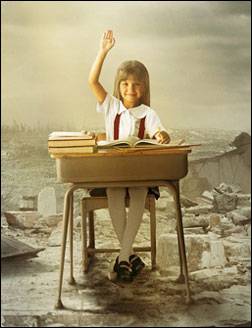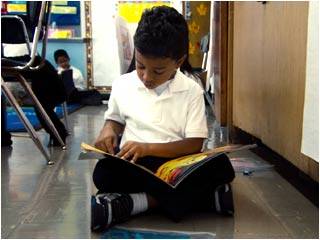 Waiting for Superman continues to garner critical acclaim, picking up the 2010 Sundance Film
Waiting for Superman continues to garner critical acclaim, picking up the 2010 Sundance Film
Festival Audience Award and winning “Best Documentary” at the Critics’ Choice Award. The
issues in the film continue to remain in the public forum as states scramble to figure out how to
best fill the educational voids that affect our children; indeed Illinois is currently trying to pass
controversial landmark reform that will affect change. The problems facing our educational
system are far from being solved, but the dialogue is not ceasing and the conversations that
continue will only contribute to creating an optimal educational environment for America’s
children.
Superman is the superhero that swoops in, blazing in his blue costume and swishing in his red cape, to save the day. Just before the car blows up, the man shoots the gun, the baby is kidnapped, he appears to stop anything bad from happening, just in the nick of time.
However, as the documentary, Waiting for Superman, glumly relates: “No one is coming with enough power to save us.” As a nation, we aggressively confront terrorism, the health care system, and foreign policies, but we seem paralyzed in our efforts to remedy our public school system. Students, teachers, families, and entire communities are floundering and are effectively being told to grab a life raft and save themselves. Everyone can see that this Titanic of sorts is sinking, but no one knows how to keep it afloat.
Waiting for Superman is a documentary directed by Davis Guggenheim (of An Inconvenient Truth fame) that attempts to examine the shortcomings of our public schools. This film has garnered a lot of attention and everyone from Oprah to the teacher unions wants to contribute to this discussion. Undeniably, our nation’s public school system is at a critical level. The documentary forces us to confront some sobering statistics about education, not the least of which is the fact that The U.S. ranks a dismal 25th out of developed countries for our education system. As Geoffrey Canada, a leading educational reformer explains in the film: “In public schools today, we place our children and their future in the hands of luck.” 
The film chronicles the evolution of educational reform in our country that seems to have flat-lined our students’ performance scores and crippled educators’ capabilities. Ask any teacher about the effects of Bush and Kennedy’s landmark, No Child Left Behind Act, and you will get an earful. Suddenly, both students and teachers have been forced to embrace a standardized test-taking culture. Students, however, have no real incentive to perform well on these exams as it does not affect their grades, their class performance, etc. For teachers and schools, the repercussions are very real and could cost them their status, their reputations, and even their jobs if their students are not considered up to state standards of education.
 The film alternates between such statistical analysis and personal human interest by profiling five children — Anthony, Bianca, Daisy, Emily, and Francisco — who are students around the U.S. and are floundering in the some of our nation’s poorest public schools. They all have dreams of getting a good education, but must bank their hopes on winning an elusive lottery for charter school acceptance in order to have those hopes realized. They are competing against hundreds of students for a few lucky spots that could mean the difference between success or stagnation. These children and their parents, desperate to provide educational opportunities, break our hearts as we witness their struggles to attain what should be a basic human right.
The film alternates between such statistical analysis and personal human interest by profiling five children — Anthony, Bianca, Daisy, Emily, and Francisco — who are students around the U.S. and are floundering in the some of our nation’s poorest public schools. They all have dreams of getting a good education, but must bank their hopes on winning an elusive lottery for charter school acceptance in order to have those hopes realized. They are competing against hundreds of students for a few lucky spots that could mean the difference between success or stagnation. These children and their parents, desperate to provide educational opportunities, break our hearts as we witness their struggles to attain what should be a basic human right.
“Good teachers” are put forth by the film as the logical solution to this educational crisis. If in effect, good teachers were present in all schools, children like those profiled would not have to play “Powerball” with their education. However, tenured teachers are presented as a major obstacle to this possibility. Enter Michelle Rhee. Her reign as the controversial chancell or of the Washington D.C. public schools ― considered the worst schools in the U.S. — is examined in the film. She attempted to work towards educational reform by firing hundreds of teachers and administrators that she felt were underperforming, including the principal of her own children’s school. Fiercely opinionated, driven, and relentless, she seemed dedicated to providing radical educational change. Like her or loathe her, she was doing just that. Since the film wrapped, Rhee resigned her position due to political pressure, not exactly the message of hope many of us longed for while viewing the film.
or of the Washington D.C. public schools ― considered the worst schools in the U.S. — is examined in the film. She attempted to work towards educational reform by firing hundreds of teachers and administrators that she felt were underperforming, including the principal of her own children’s school. Fiercely opinionated, driven, and relentless, she seemed dedicated to providing radical educational change. Like her or loathe her, she was doing just that. Since the film wrapped, Rhee resigned her position due to political pressure, not exactly the message of hope many of us longed for while viewing the film.
Davis Guggenheim readily admits that he drives past three public schools every morning in order to take his children to a charter school in an adjacent state. He is fortunate enough to have such options. However, the children profiled, and countless others, do not have such choices.
The film asks a poignant question: What is our obligation to other people’s children?
The answer to this question is not readily answered and the film is a bit too simplistic in its explorations. Good teaching is not simply just putting theory into practice — it is navigating through a maze of behaviors that are not so easily managed. The film fails to address issues of discipline that challenge teachers to effectively do their jobs and even students with special educational needs, which would not be serviced at privately owned charter schools.
One thing, however, is certain: Education should not be granted to the winner of a lucky lottery ticket … it should be the right of all who actively seek it. Superman may not be coming to save the day, but it is time that we, as a nation, tap into our own superhuman abilities to save our schools and save our own children. Kryptonite be damned.
Waiting for Superman will be playing on Wednesday, January 26 at the Art Theater as a part of the Documentary Festival, with two showings at 5:30pm and 7pm.
Runtime:1 hr 42 min — Rated PG — Documentary








